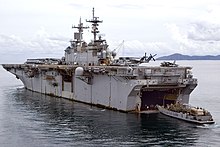USS Essex (LHD-2)
| USS Essex (LHD-2) | |
| History | |
|---|---|
| Ordered | 10 September 1986 |
| Laid down | 20 March 1989 |
| Launched | 23 February 1991 |
| Commissioned | 17 October 1992 |
| Homeport | Sasebo, Japan |
| Status | Template:Ship fate box active in service |
| Badge |  |
| General characteristics | |
| Displacement | 40,500 tons (empty) |
| Length | 844 ft (257 m) |
| Beam | 106 ft (32 m) |
| Draft | 28 ft (8.5 m) (full load) |
| Propulsion | Geared steam turbines |
| Speed | 24+ knots |
| Boats & landing craft carried | 3 LCACs or 2 LCUs |
| Troops | 1,800 |
| Complement | 73 officers, 1109 enlisted |
| Armament | RAM, NATO Sea Sparrow, Mk 15 CIWS, .50-caliber M2HB machine gun |
| Aircraft carried | up to 36, including: UH-1N Huey, AH-1W Cobra, CH-53 Super Stallion, CH-46 Sea Knight, MH-60 Seahawk, AV-8B Harrier |
USS Essex (LHD-2) is a Wasp-class amphibious assault ship built at what is now the Northrop Grumman Shipyard in Pascagoula, Mississippi, and commissioned on 17 October 1992 while moored at North Island NAS beside the Kitty Hawk (CV-63). It is the fifth ship named for Essex County, Massachusetts. Dick Cheney, then the Secretary of Defense in the first Bush Administration, spoke at the commissioning ceremony. Essex is currently serving as the command ship for Expeditionary Strike Group Seven led by the Commander, Task Force 76.
History

Essex conducted an arduous and highly successful training program during the spring of 1993, and from August 18th until November 23rd, was undergoing upgrades, during Post Shakedown Availability, in Long Beach harbor, while her crew was at 4 section duty. Her maiden deployment was in October 1994. With the 13th Marine Expeditionary Unit (Special Operations Capable) embarked, Essex showcased her abilities on numerous occasions. The highlight of the deployment came in January 1995, when she left the Persian Gulf to prepare for the complex task of covering the withdrawal of United Nations multinational force from Somalia in Operation United Shield. Under fire from advancing Somalis, every member of the force was successfully extracted. Essex returned to San Diego on 25 April 1995.
After a short maintenance period, Essex embarked on a vigorous workup cycle, culminating in her participation in RIMPAC ’96, a biennial, seven-nation naval exercise. On 10 October 1996, she embarked on her second Western Pacific deployment, with the 11th Marine Expeditionary Unit (SOC) and Amphibious Squadron Five.
During the deployment, Essex participated in multinational exercises with Qatar, Oman and Kuwait, as well as Exercise Tandem Thrust ’97, an American-Australian combined exercise with over 28,000 troops, 250 aircraft and 40 ships participating.
Upon her return in April 1997, Essex again went into a short maintenance period, followed by a shortened workup cycle. She then departed for her third Western Pacific, Indian Ocean and Persian Gulf deployment on 22 June 1998 with the 15th MEU (SOC) and Amphibious Squadron Five.
Essex participated in Exercises Sea Soldier and Red Reef, and participated in Military SALT and Non-Combatant Evacuation Operations with the U.S. Embassy in Kuwait. Additionally, Essex supported Operation Southern Watch, enforcing the UN-mandated no-fly zone over southern Iraq.
On 26 July 2000, after successful completion of the largest crew swap in U.S. Navy history, Essex replaced Belleau Wood (LHA-3) and inherited the distinctive role as the Navy’s only permanently forward-deployed Amphibious Assault Ship in United States Fleet Activities Sasebo, Japan.
In the role, Essex has participated in various humanitarian assistance/disaster relief operations including East Timor in October and November 2001 and Foal Eagle in Korea in 2002.
In 2004, Essex carried the 31st Marine Expeditionary Unit (31st MEU) to Kuwait. Along with USS Harpers Ferry (LSD-49) and USS Juneau (LPD-10). Essex stayed in the Persian Gulf while the 31st MEU and the combat element 1st Battalion, 3rd Marines went into Iraq for the Battle of Fallujah. During that time, Essex went to aid in Operation Unified Assistance in Banda Aceh, Indonesia after the St. Stephen's Day 2004 Tsunami. She then returned to the Persian Gulf to embark the 31st MEU SOC and the combat element despite being in need of maintenance. After picking up the MEU and the Combat Element, the three ships returned to Okinawa, Japan. The ship had been at sea a total of 8 months.
During the 2008 Myanmar Cyclone Nargis crisis and the subsequent Operation Caring Response aid mission, the Essex and her carrier group (made up of the USS Juneau, the USS Harpers Ferry, and the USS Mustin) stood by off Burma from May 13 to June 5, waiting for the Myanmar junta government to permit US aid to its citizens.[1] However, in early June, with permission still not forthcoming, it was decided to put the group back on its scheduled operations.[2]
Unit awards
Since her commissioning, Essex has received numerous awards, including all of the warfare excellence awards, seven Battle “E” awards (most recently in 2006 [1]), the Golden Anchor Award for retention, the Ney Award for food service excellence, the Thompson Award for public affairs excellence, the Ogden Award for firefighting excellence, and the Chief of Naval Operations and Commander, Naval Surface Forces Pacific Safety Award.
Popular Culture
The Essex has been seen in various maps of the popular online combat game Battlefield 2, and Battlefield 2: Special Forces. It's usage includes a pair of Phalanx cannons, F-35 Lightning fighters, Seahawk transport helicopters, and AH-1Z attack helicopters. It is also used as a spawning point for the United States Marine Corps team on the maps it's featured in.
